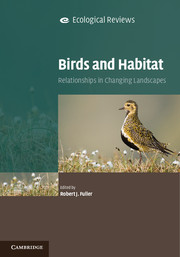Book contents
- Frontmatter
- Contents
- List of Contributors
- Preface
- Part I The complexity of patterns and processes
- Part II Case studies of habitat use and selection
- Chapter Eight Spatial variation and habitat relationships in moorland bird assemblages: a British perspective
- Chapter Nine Arctic-alpine mountain birds in northern Europe: contrasts between specialists and generalists
- Chapter Ten Bird–habitat relationships in reedswamps and fens
- Chapter Eleven Breeding waders on wet grassland: factors influencing habitat suitability
- Chapter Twelve Processes influencing bird use of estuarine mudflats and saltmarshes in western Europe
- Chapter Thirteen Avian habitat use on the non-estuarine intertidal coast
- Chapter Fourteen Temperate western European woodland as a dynamic environment for birds: a resource-based view
- Part III Wider perspectives
- Species index
- Subject index
- References
Chapter Ten - Bird–habitat relationships in reedswamps and fens
Published online by Cambridge University Press: 05 December 2012
- Frontmatter
- Contents
- List of Contributors
- Preface
- Part I The complexity of patterns and processes
- Part II Case studies of habitat use and selection
- Chapter Eight Spatial variation and habitat relationships in moorland bird assemblages: a British perspective
- Chapter Nine Arctic-alpine mountain birds in northern Europe: contrasts between specialists and generalists
- Chapter Ten Bird–habitat relationships in reedswamps and fens
- Chapter Eleven Breeding waders on wet grassland: factors influencing habitat suitability
- Chapter Twelve Processes influencing bird use of estuarine mudflats and saltmarshes in western Europe
- Chapter Thirteen Avian habitat use on the non-estuarine intertidal coast
- Chapter Fourteen Temperate western European woodland as a dynamic environment for birds: a resource-based view
- Part III Wider perspectives
- Species index
- Subject index
- References
Summary
This chapter focuses on the habitat relationships of birds that are closely associated with reedswamps and fens in western Europe. These are normally waterlogged habitats with vegetation frequently dominated by tall robust plant species. They embrace an extremely diverse range of ecological conditions, often described by tortuous technical terminology. Classification systems struggle to capture the fluid and fragile nature of these dynamic environments that change through time with hydroseral succession and frequently grade into one another in space. Water chemistry and the physical processes that create the waterlogged conditions underpin much of the complex variation in plant communities (e.g. Rodwell, 1995). Using British examples, this section introduces the variety of habitat types which, although generally very localised, support highly distinctive bird assemblages.
‘Reedbeds’ are dominated mainly by common reed Phragmites australis. The term ‘reedswamp’ refers to the wettest reedbeds, with at least 20 cm or more of standing water throughout the year. Early successional areas may be dominated by Typha latifolia, T. angustifolia or Schoenoplectus lacustris (Rodwell, 1995). Reedswamp may develop from open water, into swamp, then to waterlogged woodland (‘carr’) and eventually to relatively dry woodland. This succession is only arrested by grazing or cutting, or natural disturbance such as severe winter flooding. Reedswamp is not necessarily confined to peat-based, water-retentive soils; it can rapidly colonise mineral extraction sites, natural lake margins and estuaries with a variety of substrates. Reedbeds are relatively rare in Britain: a total of 5000 ha was recorded in 1993, with only 50 sites larger than 20 ha (Gilbert et al., 1996). Recent creation and restoration projects are substantially increasing reedbed area. For example, three newly created sites in Somerset, Suffolk and Cambridgeshire will eventually provide at least another 1000 ha.
- Type
- Chapter
- Information
- Birds and HabitatRelationships in Changing Landscapes, pp. 253 - 277Publisher: Cambridge University PressPrint publication year: 2012
References
- 1
- Cited by



